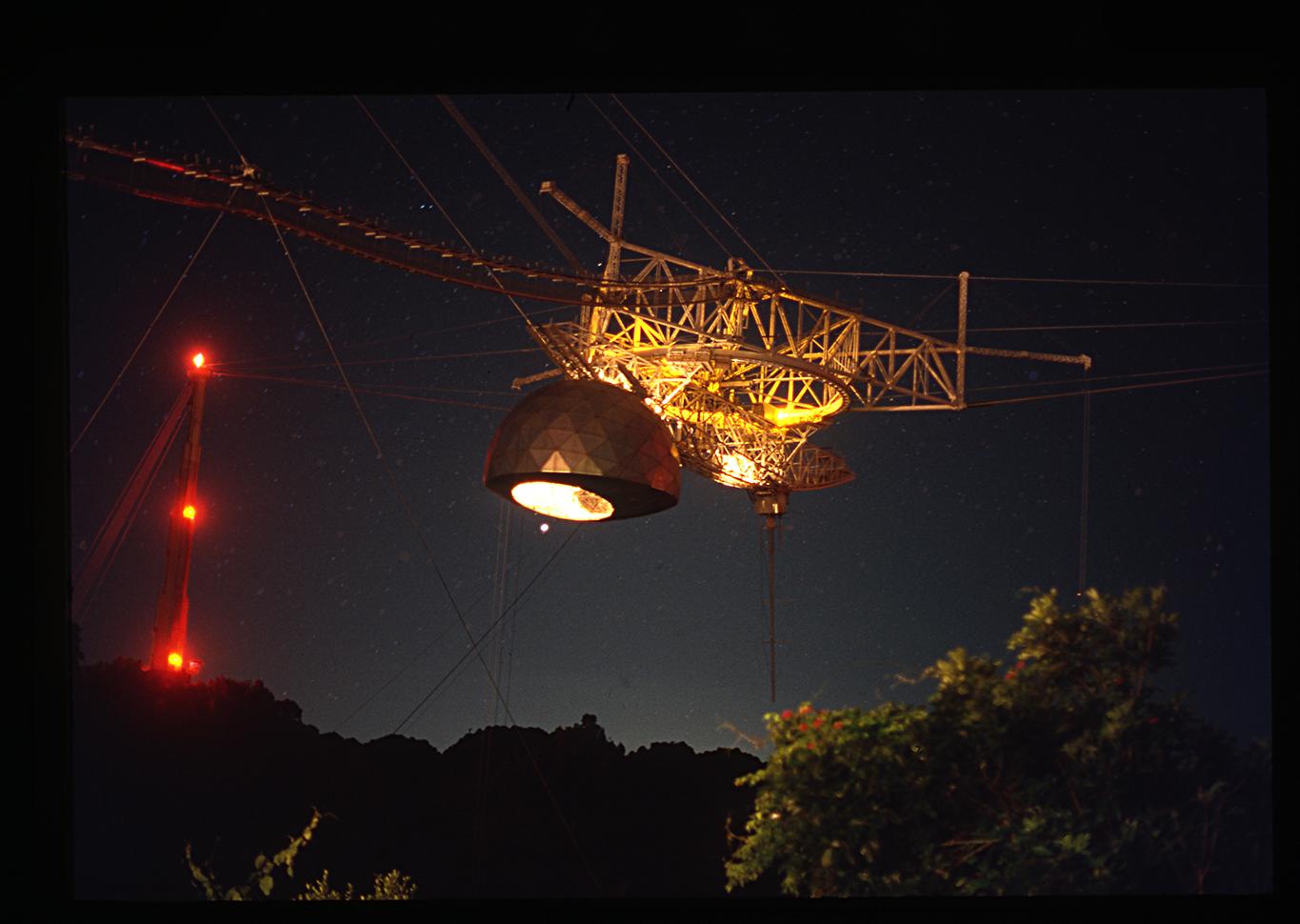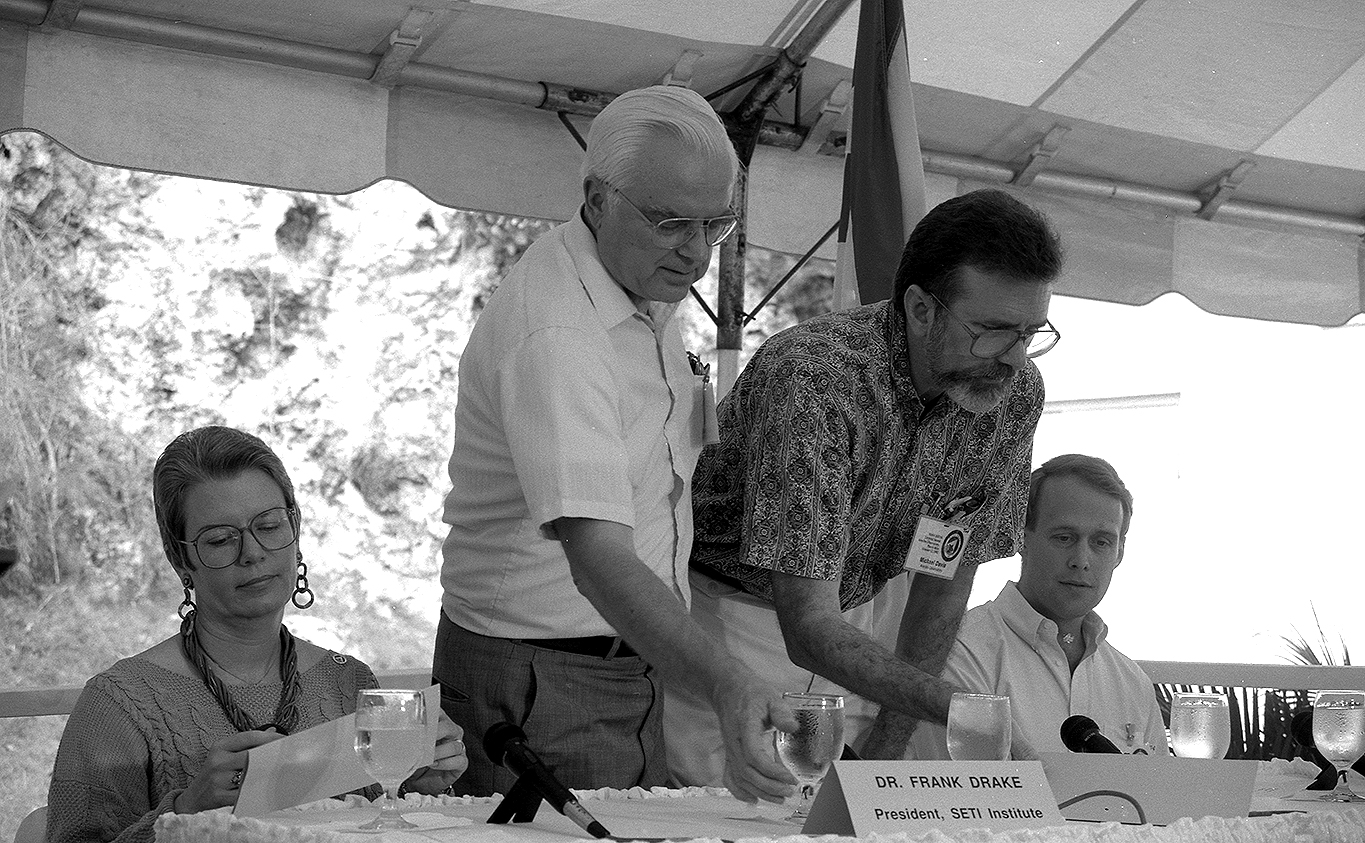
UPDATE: On December 1, 2020, the Arecibo Observatory collapsed following its decommissioning by the National Science Foundation the previous month. No injuries were reported.
For a half-century, it was the largest radio telescope in the world. But the Arecibo antenna will soon be taken apart and trucked away.
One of small number of cables (each as thick as your arm) holding the receiver platform high above the dish failed last August. Despite this calamity, plans were quickly drawn up for repair. Then, on November 6, a sister cable gave way. Engineers realized that the mechanical health of the telescope was far poorer than they had believed. The National Science Foundation, which had long sponsored the instrument, declared it mortally wounded.
Arecibo was always the big guy on the team. Its 1,000-foot diameter main reflector, constructed of aluminum panels perforated like ceiling tile, is hunkered down in a natural sinkhole in the karst of northwestern Puerto Rico. This location was no accident. Since early plans for the instrument foresaw study of the solar system, a site close to the equator was desirable. The planets would then pass more or less overhead.
The most southern real estate in the U.S. is on Hawaii’s big island, but the Cornell team designing the instrument figured that Hawaii was too far from Ithaca, and opted instead for Puerto Rico. It’s said that the telescope’s principal architect, Cornell engineer William Gordon, chose its exact location by sliding a nickel around a topographic map of Puerto Rico until he found a natural depression in which the antenna would fit.
For a half-century, Arecibo’s size, and consequent sensitivity, were unrivaled. New Mexico’s Very Large Array has but one-fifth the collecting area, despite sporting 27 antennas. The VLA would get lost in the vast aluminum expanse of Arecibo’s main reflector.
The telescope has some limitations: It can only be aimed over a 40 degree range of angles at any given time. But the Earth’s rotation means that, over the course of a day, approximately one-third of the cosmos is accessible to Arecibo. For most observing programs, that’s plenty.
But while it can see much of the sky, Arecibo does so with a telephoto lens. Its typical field of view is ten times narrower than the full moon. Like other single-dish antennas, it doesn’t have the resolution – the ability to see small detail – that antenna arrays can deliver. Precise radio maps of the heavens are not its métier.
However, when your research is all about photons – about studying weak or distant emitters of radio waves – then Arecibo goes to the head of the class. It’s simply a bigger bucket for collecting radio waves coming to us from elsewhere in the universe. I spent a lot of time at Arecibo studying galaxies that were many millions of light-years away. The antenna is also frequently used for pulsar research and measurement of the emission from planets in our own solar system. Even sky-savvy folk seem to forget that it was Arecibo that Polish astronomer Alex Wolszczsan used to discover the first planet around another star in 1992.
There’s another thing that distinguishes Arecibo from its dishy peers: An ability to transmit. When it was first planned, Arecibo’s number one assignment was expected to be a routine aiming of its transmitter at the sky to measure the amount of energy reflected from the ionosphere. Better understanding of the idiosyncrasies of this charged atmospheric layer was important for long-distance radio communication, a matter of considerable interest to the military. This capability led to the moniker given the telescope by the Puerto Rican locals: El Radar.
While such studies have continued, Arecibo’s monster 2 megawatt transmitter has been used for other projects, including early mapping of the topography of cloud-covered Venus and more recent studies of asteroids. But perhaps its most celebrated transmitting experiment took place in 1974 when Frank Drake – the observatory director at the time – celebrated an upgrade to the antenna by transmitting a 3 minute-long, friendly message to the globular star cluster, M13. This was, and remains, the most powerful message ever sent from Earth. Given the cluster’s distance, you can expect a reply in about 44,000 years. Or not.

However, Arecibo’s efforts to locate alien societies have largely been its listening experiments: SETI. While there were some early SETI observations made on an ad hoc basis, in 1992 the NASA SETI Program began a study of 1,000 star systems at Arecibo. Some of these stars were several hundred light-years away, so Arecibo’s unrivaled sensitivity was a major selling point.
After the cancellation of the NASA program scarcely a year later, private- and university-funded projects kept Arecibo in the SETI game. The Berkeley SETI group ran a piggyback observing program that took advantage of a second receiver on the antenna to observe random parts of the sky while the main receiver was in use by other astronomers. The SETI Institute used Arecibo for three years beginning in 1998 as part of its Project Phoenix, a scrutiny of about 800 nearby star systems.
For those astronomers and SETI researchers who have spent time at the Puerto Rican installation, the loss of this telescope is akin to hearing that your high school has burned down. Observing at Arecibo was much like going to summer camp. You had one job: do the experiment, while enjoying the conviviality of the friendly local telescope operators and staff, as well as the kitchen’s first-rate chicken-and-rice dinners. For two weeks you were on-site while the rest of the world, with its incessant demands and petty annoyances, vanished in the haze of distance.
Losing Arecibo is like losing a big brother. While life will continue, something powerful and profoundly wonderful is gone.
Por Seth Shostak, Astrónomo Senior
Traducido por Lourdes Cahuich
Durante medio siglo fuel el radio telescopio más grande del mundo, pero pronto la antena de Arecibo será desmantelada y retirada.
Un pequeño número de cables (cada uno tan grueso como su brazo) que sostienen la plataforma del receptor por arriba del disco, fallaron en el pasado agosto. A pesar de esta calamidad, los planes eran hacer reparaciones pronto. Pero después, el 6 de noviembre, un cable hermano cedió. Los ingenieros se dieron cuenta de que la salud mecánica del telescopio era peor de lo que esperaban. La National Science Foundation, que durante mucho tiempo financió el instrumento, declaró que estaba mortalmente herido.
El radio telescopio de Arecibo, siempre fue el grandote del equipo, su reflector principal de 1,000 pies (poco más de 300 metros) de diámetro, construido de paneles de aluminio, perforados como un cielo raso, abarca un sumidero natural en el karst del noroeste de Puerto Rico. Esta ubicación no fue accidental, debido a que los primeros planes para el instrumento preveían el estudio del Sistema Solar, era deseable que estuviera cerca del ecuador. Los planetas pasarían más o menos por arriba de éste.
La propiedad inmobiliaria más al sur de los EE. UU. se encuentra en la gran isla de Hawái, pero el equipo de Cornell que diseñó el instrumento pensó que Hawái estaba demasiado lejos de Ithaca y optó por Puerto Rico. Se dice que el arquitecto principal del telescopio, el ingeniero de Cornell, William Gordon, eligió su ubicación exacta deslizando una moneda de cinco centavos alrededor de un mapa topográfico de Puerto Rico hasta que encontró una depresión natural en la que encajaría la antena.
Durante medio siglo, el tamaño de Arecibo y la consiguiente sensibilidad no tuvieron rival. El Conjunto Muy Grande (VLA por sus siglas en inglés) en Nuevo México, tiene solo una quinta parte del área de recolección, a pesar de tener 27 antenas. El VLA se perdería en la vasta extensión de aluminio del reflector principal de Arecibo.
El telescopio tiene algunas limitaciones: solo puede apuntarse en un rango de ángulos de 40 grados en un momento dado. Pero la rotación de la Tierra significa que, en el transcurso de un día, aproximadamente un tercio del cosmos es accesible a Arecibo. Para la mayoría de los programas de observación, eso es más que suficiente.
Pero si bien puede ver gran parte del cielo, Arecibo lo hace como un teleobjetivo. Su campo de visión típico es diez veces más estrecho que la luna llena. Al igual que otras antenas de un solo plato, no tiene la resolución o la capacidad de ver pequeños detalles, que pueden ofrecer los conjuntos de antenas. La cartografía precisa en radio de los cielos no son su forte.

Sin embargo, cuando tu investigación tiene que ver con los fotones -estudiar de emisores débiles o distantes de ondas de radio- entonces Arecibo va a la cabeza de la clase. Es simplemente el cubo más grande para recolectar ondas de radio que nos llegan de otras partes del universo. Yo pasé mucho tiempo en Arecibo, estudiando galaxias que estaban a muchos millones de años luz de distancia. La antena también se utiliza con frecuencia para la investigación de púlsares y la medición de las emisiones de los planetas de nuestro propio sistema solar. Incluso la gente conocedora del cielo parece olvidar que el astrónomo polaco Alex Wolszczsan utilizó el telescopio de Arecibo para descubrir el primer planeta alrededor de otra estrella en 1992.
Hay otra cosa que distingue a Arecibo de sus pares populares: la capacidad de transmitir. Cuando se planeó por primera vez, se esperaba que la tarea principal de Arecibo fuera el uso rutinario de su transmisor hacia el cielo, para medir la cantidad de energía reflejada de la ionosfera. Una mejor comprensión de las idiosincrasias de esta capa atmosférica cargada fue importante para la comunicación por radio a larga distancia, un asunto de considerable interés para los militares. Esta capacidad llevó al apodo que los lugareños le dieron al telescopio: El Radar.
Aunque dichos estudios han continuado, el monstruoso transmisor de 2 megawatt de Arecibo ha sido usado para otros proyectos, incluyendo la cartografía topográfica del nublado Venus, y más recientes estudios de asteroides. Pero quizá su experimento de transmisión más celebrado tuvo lugar en 1974, cuando Frank Drake, quien era el director del observatorio en ese momento- celebró la actualización de la antena al transmitir un mensaje amigable de 3 minutos de duración, hacia el cúmulo globular M13. Este fue, y sigue siendo, el mensaje más potente que se ha enviado desde la Tierra. Dado que la distancia al cúmulo, podemos esperar una respuesta dentro de 44,000 años. O no.





